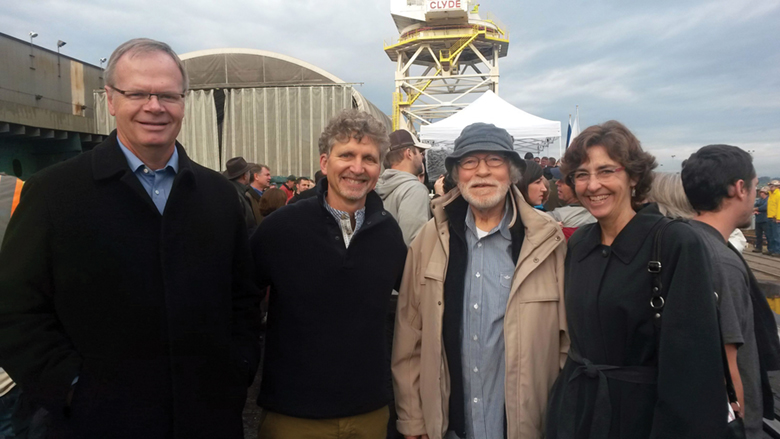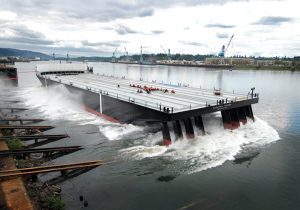
In 1997, after 18 years working as a naval architect and planner at shipyards and for a naval architecture firm, Hal Hockema founded his own naval architecture firm, Seattle-based Hal Hockema & Associates.
And over the past 25 years, Hockema Group as the company is now known, has become a full service independent naval architecture firm primarily involved in commercial and government projects in various sectors of the marine industry.
It provides naval architecture and marine engineering services for tugs, barges, commercial fishing vessels, dredgers, cargo vessels, workboats and passenger vessels, as well as government/military service vessels. The company’s work is balanced between new construction design, conversion/modification design and consulting.
As the company that Hal Hockema founded prepares to celebrate its silver anniversary this fall, Pacific Maritime Magazine takes a look at its past, present and potential future.
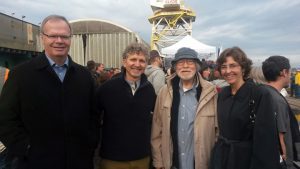
The Past
Hal Hockema, who grew up in Newport, Oregon, first became interested in vessel design while working summer jobs at the docks and on fishing vessels as a young man. He also had two older brothers who were career commercial fishermen.
“That was an influence, definitely,” he said of their occupations’ effect on his career choice.
After studying at Oregon State University’s College of Engineering from 1975-1979, he returned to the maritime industry.
“I started (as a shipyard trainee) in 1979 working at MARCO (Marine Construction & Design Co.) shipyard; that was kind of the last year of the crab boat boom,” he explained to Pacific Maritime Magazine. “We built 10 boats in one year, which was quite an accomplishment—they’ve never done that since.”
Eventually, after working for a number of employers, including an 11-year stint with Seattle-based Jensen Maritime Consultants, Hockema decided to become his own boss.
“In ’97, Hal had been the vice president of Jensen Maritime at the point,” Hockema Group President John Myers told Pacific Maritime. “He’d been the vice president for a number of years and he made the decision to go out on his own and that was the inception of the company, at that point.”
Hockema told Pacific Maritime that his initial vision, aside from his basic design and business philosophies, was to work from a home office so he could avoid an urban commute in Seattle, have more time with his family, contribute less to traffic congestion and improve his overall productivity as a naval architect.
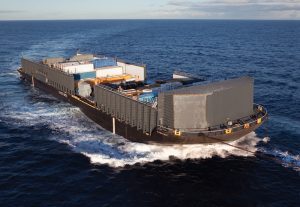
Hal’s wife Julie Hockema came aboard not long after the company was launched.
“Julie joined the form soon after I founded it, and she was the business manager for 24 years” before retiring last year,” Hal Hockema said. “Julie was very involved with the company.”
An important milestone for the firm occurred in 2004 when Hal Hockema & Associates Inc. purchased the assets of engineering services company Fisker-Andersen & Whalen Inc. and the company name was changed to Hockema & Whalen Associates, Inc.
Fisker-Andersen & Whalen dated back to 1974 when Jacob Fisker-Andersen founded J. Fisker-Andersen Inc. in 1974 in Seattle. Fisker-Andersen was a Danish immigrant who came from a family with historical shipyard ties in Denmark.
In Seattle, he worked in fishing vessel design, tug design and barge design throughout the 1970s and ‘80s. Michael Whalen purchased the assets of J. Fisker-Andersen Inc. from Jacob in 1992 and the company became Fisker-Andersen & Whalen Inc.
“The Fisker-Andersen & Whalen side of the company brought us a tremendous amount of tug and barge design work, especially on the barge side,” Hockema said.
Whalen remained with Hockema Whalen Myers Associates as a Senior Principal until retiring in 2020. He does, however, still design fuel-efficient deck cargo barges for the company.
“He’s a wealth of knowledge and a great guy, a super good naval architect,” Hal Hockema said of Whalen.
Myers joined the company in 2005, after Hal Hockema had purchased the business from Mike Whalen and the business became Hockema, Whalen & Associates.
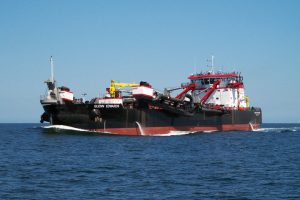
“I was their first employee, I’ve been here since that point in ’05,” Myers said. “I was the first naval architect they brought on, and the business since that time has just slowly grown. We’ve worked with a number of customers, primarily based here in the Pacific Northwest (and) predominantly in the fishing industry, dredging, workboats, tug & barge.”
“The company has predominantly been working with those main customer bases that we’ve had—Lynden, Sause, Manson, Trident Seafoods and quite a few other seafood companies,” he added.
In 2018, after 13 years with the firm, Myers became a part owner, and the company again changed its name, this time to Hockema Whalen Myers Associates, Inc. Then, in January 2021 the name changed yet again, this time to Hockema Group, Inc.
The change coincided with Hal and Julie Hockema stepping back from their daily management duties of the company and Myers ascending to the company’s presidency. Hal has taken on the role of chairman and works about 20 or so hours a week.
“I’m 65 now; there were other things I wanted to do in my life other than naval architecture,” Hal Hockema explained. “Not as much stress (being semi-retired), a little more time for vacation and travel and a little more time for my family.”
The Present
“We (now) have 12 full-time employees and we have a host of individual subcontractors that our firm regularly utilizes, these are trusted individuals who are either supplemental people or providing other engineering specialty disciplines for us,” Myers said. “And so our little company can take on pretty large projects as needed, and the way that we accomplish that is by swelling in size when the demands are there by bringing in a lot of those subcontractors.”
“We also will occasionally work with other peer naval architectural firms—Elliott Bay, Glosten, Crowley—as needed in order to pool additional resources for some of the larger projects that we work on,” he added.
Although Hockema Group maintains a central office in Seattle, all staff members primarily work from their home offices.
“For many years now, we’ve been in a remote work environment company, well before COVID,” Myers explained. “It provides our very small company of 12 people…it gives us kind of a wide footprint. Our 12 employees are in five different states. There’s a lot of flexibility there and access to ports, shipyards and operators because our few numbers are spread out in a big way.”
However, despite the firm’s staff all working from home, the pandemic still had an effect on operations.
“COVID-19 came along and really put a damper on our business, especially on the commercial fishing (vessel design) side,” Hockema said. “There were some shutdowns in the factory trawler fleet as well as the shoreside processing plants because of COVID-19, and those disruptions pulled vessel owners’ completely attention away from any modifications or new vessels or anything like that being built. They were concentrating all their efforts for at least 18 months on disease prevention.”
But despite that said, his company was able to keep all its staff on, and managed to pivot to other areas, like federal work proposals and other categories of work, and that it looks like some proposals will pan out in long run.
“Sometimes challenges can be an opportunity if you treat them correctly,” he remarked.
As far as his own work schedule, Hockema said that he’s currently working one day a week, plus participates in “projects of interest.”
“I’m still interested in the business—very much so. My role is pretty much two-fold now. One is management consulting, which is offering advice to our current managers while not being out front as the main voice of the company,” he said. “And the other (role) is in design. If you’re president (of the company) you don’t get a lot of time to do the design work — and that’s why we all go into this business to start with. I wanted to circle back and do some more design work, so that’s what I’m doing.”
Currently, he said he’s working on a new construction barge project, as well as other things regarding fishing vessel design and tug design. On the management consulting side, has been assisting Myers and others with proposals made to the federal government on potential contracts.
“The design side is still something that interests me; I think I will be doing that indefinitely,” he remarked.
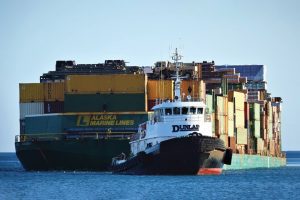
The Future
Hockema Group has completed a design for Manson Construction for the new hopper dredge Frederick Paup, and when it’s constructed, according to Hockema, it’ll be the largest capacity hopper dredge in the United States at 15,000-plus cubic yard capacity and it’s 420 feet long. It’s currently under construction in Brownsville, Texas.
“That one is very exciting—a big project in every way,” Hockema said, adding that a delivery date is expected in 2023. “It’s a major project for us, the largest we’ve ever done. It should be interesting to see that come online in another year or so.”
He also mentioned a 362-foot deck barge project currently being built at Gunderson Marine for Matson to be used for shipping to Hawaii. The barge’s design is an update of a current 362-foot barge now in use.
“We have a 286-foot barge that I’m working on right now for another client—I can’t expand too much on the details right now, it’s very early,” he said, adding that the firm also continues to do a lot of fishing vessel design.
“In other areas, we’ve been making some inroads in U.S. Army Corps of Engineers projects; they have a lot of marine projects, so we’ve been applying to some of those opportunities,” Hockema said. “That will be a significant change for us if we do. It would be somewhat of a growth driver for us.”
He added that the company would also like to grow from 12 employees to 15-20 over time.
“We don’t want to grow for the sake of growing; we want to grow because we want to do good work, and growth in some sectors of the industry allows you to do better work for your clients, especially on larger projects,” he explained.
As far as his own working life, Hockema said that it’s not close to ending.
“For me, I think what I’m doing now is going to be for another 10 years or so—it’s pretty much indefinite,” he commented. “The exact format of that may change over time depending on the company needs and my own personal needs, but I still enjoy being part of the company and don’t see that changing for a long time.”
“We want to continue to do the good work we do for our current clientele,” he said, adding that offshore work is another thing that the company is looking at pursuing.
“At this time, I can’t say specifically what we are doing in that sector, but it is something we are pursuing,” he commented.
For nearly 25 years now, Hockema Group has managed to gradually grow and expand and Myers said a large reason behind the firm’s success has been its business philosophy.
“One of the main principles that we try to live by day-to-day is to look out for the success of all the players involved,” said Myers, who’s now a part owner of the company, along with Hal and Julie Hockema.
“I think sometimes there is a teaming up or a this versus them kind of attitude that can sometimes take place in contracting and construction and so forth,” he said. “From our perspective, that just instills some level of mistrust or can sow the seeds of failure in projects, so from our perspective while we look out for our clients, number one, we also want to ensure the success of the other parties that are involved in the projects that we work on—shipyards, vendors and other subcontractors that are involved.”
“If everybody is informed and player at the table and everybody is felt respected and worthy of working on a particular project, then that project is going to succeed and everybody’s going to benefit from it,” he continued. “And those people who may not have been our direct customer on that project may be our direct customer in the future. It’s just in everybody’s interest to approach the work that they do with a positive attitude, and I think from the beginning, Hal has instilled that in the firm, and he has found a client base which equally believes in that as a core business principle.”
“The customers that I look at that we have today, many of our best customers are ones that Hal and Mike Whalen brought forth 25 years ago—Dunlap Towing Manson Construction, Trident Seafoods, Sause Bros.—these are big operators in the (Pacific) Northwest and we were working for them then and we’re working with them even more today,” Myers continued. “So, while we’ve expanded our customer base, those companies that were with us at the beginning are still with us today and bigger than they’ve ever been. If you have good customers, they’re going to come back to you.”
Hal Hockema echoed those words.
“Fairness to everyone involved in important because we all need each other,” he commented. “We all want success in the project so that we can do business together in the future.”

